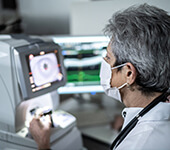Welcome to another edition of our Embedded Vision podcast, Vision Vitals. It's where we explore the latest trends in Embedded Vision technology. This is Anushya, your host for today. I'm the partner marketer here. In the second episode, I'll be talking to Suganthi Sugumaran, the director of marketing at e-con Systems. Today, we'll be talking about something that many of you may have already experienced in your daily lives autonomous Shopping. That's right, We'll be untangling the bold and excited world of this new age shopping approach, which is spearheaded by Embedded Vision technology. So let's get started. Suganthi, when you hear Autonomous Shopping, what's the first thought that comes to your mind? What do you think about the evolution of shopping technology from traditional in-store experiences to the era of Autonomous Shopping?
Hi, Anushya, Thank you for hosting me. When I think of Autonomous Shopping, I'm transported back to conversations from a decade ago. This concept, once a mere whisper in the retail world, has now blossomed into a full-fledged shopping revolution. The journey has been remarkable, starting from the traditional in-store experience, where every transaction and interaction was physical and direct. Then came the dawn of e-commerce, a significant leap that brought unparalleled convenience and access to a global marketplace. We shifted from physical stores to digital platforms and joined the liberty to shop from our homes. Yet this phase wasn't without its drawbacks. Actually, the personal touch, the sensory experiences with products these were often missing and at times, we gambled with quality. The evolution didn't stop there. With the advent of smart phones, shopping entered the mobile e-commerce phase, making it possible to shop with a few taps on screen, anytime, anywhere. This was followed by the use of data analytics and personalization techniques, which transformed how we interacted with online platforms. Retailers could now offer tailored shopping experiences based on our preferences and history. The emergence of omnichannel rating bridged the gap between online and physical stores, creating a seamless customer experience across various channels. This integration meant that we could enjoy the convenience of online shopping along with the tangibility of in-store experiences. But now Anushya. As we enter the era of autonomous shopping, these challenges are being addressed in normal ways. This new phase marries the meaningful interaction of traditional shopping with the online models ease and convenience. Imagine walking into a store, selecting your items and leaving without the hassle of queuing for checkout. Or consider the enhanced experience in stadiums or airports, where you can select and pay for your meal or merchandise seamlessly, without the traditional waiting times. Anushya, let me share a personal experience. Once, in a rush at an airport, I needed to grab a meal before a flight. In the past, it would have meant waiting in line, ordering and eating in hurry, but thanks to the autonomous shopping facilities at the airport, I quickly selected my meal from a digital menu, paid without any delay and enjoyed a relaxed dining experience. This moment highlighted the practical and real-world benefits of autonomous shopping. This evolution has been gradual but significant. From in-store shopping to digital era, through mobile commerce and omnichannel experiences, and now to autonomous shopping. The world has seen the advancement of embedded vision systems and retail technologies all converging to make shopping more intuitive, efficient and enjoyable. Anushya, as someone who has observed and participated in this transformation, is exhilarating to witness the emergence of the new shopping era.
Suganthi, after your experience at the airport, where you quickly selected and paid for your meal without any delay, are you able to resonate with the modern shoppers who are increasingly gravitating towards autonomous shopping systems? Do these systems address concerns about privacy and efficiency?
Suganthi Sugumaran: 4:35
35The trend towards autonomous shopping is driven by several factors on the show, each playing a vital role in shaping consumer preferences in today's fast baseball. First, streamline and predictable experiences. Autonomous shopping offers streamlined and predictable journey. In a world where time is precious, these systems minimize the delays and communication often found in traditional shopping experiences. You know the predictability and efficiency of autonomous shopping, free from the unpredictability of human errors, provide a sense of peace of mind that is highly valued by customers. Secondly, self-checkout systems entering the shoppers. The rise of self-checkout systems has been an absolute game changer. These systems put shoppers in control, offering a sense of autonomy. You can pay as your shopping experience, avoid long queues and annually purchases in a way that suits you best. This control is not just about efficiency, Anushya. It's all about personalizing the shopping experiences to fit individual preferences and needs, and when it comes to addressing privacy concerns. In the era of data-driven shopping experiences, privacy has become a paramount concern. Autonomous shopping systems, while collecting data to enhance the shopping experience, are also designed with privacy safeguards. Advanced encryption and anonymization techniques are employed to protect customer data. Moreover, Anushya, the self-serviced nature of autonomous shopping means less human interaction, which can sometimes translate into increased privacy. Actually, Modern shoppers are leaning towards autonomous shopping because it offers efficiency, control and privacy all wrapped in a package of convenience that fits perfectly into the contemporary lifestyle. As these systems evolve, they are likely to become even more integrated in our daily routines, completely redefining the shopping experience for future generations.
Anushya Jeyabal: 6:51
Okay, suganthi, I understand your point of view on privacy and efficiency. You know, recently I visited a store where autonomous systems handle checkouts efficiently. It made me wonder, from an operational perspective, how has the self-checkout systems transformed the landscape for today's retailers?
Suganthi Sugumaran: 7:12
Interesting question, anushya. The introduction of autonomous shopping systems has been a game changer for retailers, too, in many ways. Firstly, we have streamlined checkout process. Autonomous systems equipped with advanced technology can process fan sessions much more rapidly than traditional methods. This efficiency not only enhances customers' experience by reducing wait times, but also boosts the retailers' productivity. A quicker checkout process means higher throughput, allowing stores to serve more customers in less time, ultimately leading to increased sales and customer satisfaction. Secondly, there is efficient labour allocation in training. The deployment of autonomous systems in checkout operations has significantly changed the landscape of labour training and allocation in retail. The need for extensive cashier training is drastically reduced, freeing up resources for other aspects of staff development. This shift allows retail employees to be redeployed to the roles that require a human touch, such as customer service and inventory management. By reallocating staff to these areas, retailers cannot focus on providing personalized service, assisting customers with queries and ensuring the products are adequately stocked and displayed. Thirdly, anushya is all about enhanced customer service. While staff no longer tied up at checkout counters, they now available to us as customers over shop flow. This availability can lead to improved customer interactions, better service and more satisfying shopping experience. Overall, employees can now spend more time understanding customer needs, offering recommendations and enhancing overall value of in-store shopping. Finally, we get data-driven insights. Autonomous shopping systems collect a wealth of data offering retailers valuable insights to customer behaviour, shopping patterns and preferences. This data can be used to tailor marketing activities, optimize store layouts, personalize customer experiences, etc. By leveraging these insights, retailers can make more informed business decisions, ultimately leading to better customers engagement and increased profitability. In total, anushya, the operational impact of autonomous shopping on today's retailers is very, very profound. It has revolutionized the checkout process, optimized labour allocation, enhanced customer service and provided valuable data-driven insights. These changes are not just improving operational efficiencies, but, anushya they are also redefining the retail experience for both customers and retailers as well.
Anushya Jeyabal: 10:10
In terms of redefining the retail experience, I have become curious what are some of the most popular and innovative autonomous shopping systems being utilized in retail today?
Suganthi Sugumaran: 10:21
In today's retail landscape, especially post-COVID, the demand for contactless and efficient shopping experiences has led to the adoption of various innovative autonomous systems on Anushya, For example, advanced self-checkout systems. Traditional self-checkout systems are evolving beyond barcode scanning. Now some systems allow shoppers to place items on a checkout tray where advanced imaging and sensor technology quickly identifies those and adds them to the bill. This means no more individual scanning of barcodes. Shoppers can place multiple items on the tray and the system tallies everything up in seconds, streamlining the checkout process significantly. Then we have the smart trolleys. Beyond the initial scanning feature, the latest smart trolleys are equipped with sophisticated sensors and cameras. Shoppers can simply throw items into the cart and these are automatically added to the building, to objectives, recognition and wait sensors. This technology ensures that the cart knows exactly what's inside and charges accordingly, Allowing for a seamless shopping experience where the checkout process begins the moment an item hits the cart. Then we have these roof camera systems. Retail environments are now increasingly installing overhead roof cameras. These high-tech cameras provide an eagle-eye view of the shopping area, using imaging and tracking algorithms to detect what items shoppers pick up and key. They can tally a shopper's total in real time, charging their account as they exit without any need for manual scanning or stopping at a checkout line. This system is particularly effective in environments with high-value items or where speed and efficiency of the essence. Each of these systems, Anushya, represents a step forward towards more autonomous, efficient and contactless shopping experiences. They are designed to not only make shopping more convenient for consumers, but also to streamline operations and reduce overhead for retailers. You know Anushya. As technology continues to advance, it is likely we will see even more innovative solutions develop further, transforming the retail landscape into a more automated and shopper-friendly environment.
Anushya Jeyabal: 12:51
Okay, suganthi. Could you please tell us more about the differences between these three autonomous shopping systems?
Suganthi Sugumaran: 12:59
Anushya. If you take the level of interaction required, then self-checkout systems require significant customer interaction. Shoppers manually place items on the tray and complete the payment process themselves, often using a touchscreen interface or depth kiosk. Smart trolleys reduce the level of interaction needed. As shoppers add items to their trolleys, they are scanned automatically, either through barcode scanning or more advanced visual recognition technologies. This integrates the checkout process more smoothly into the shopping journey. Truth cameras or sensor-based systems Anushya, offer the least customer interaction. The system automatically identifies and tallies items taken off the shelves using overhead cameras or a combination of sensors and cameras, requiring no manual input from the shopper until the final payment, which is often automated as well. But if you take a look at the infrastructure requirements, self-checkout systems require individual kiosks equipped with scanning, weighing and payment technologies. The infrastructure includes barcode scanners, payment terminals and sometimes even conveyor bells, taking up a fair amount of floor space. If you look at smart trolleys, anushya, each trolley must be equipped with scanning technology and, in some cases, a display or interface. This represents a significant investment, as each cart becomes a piece of technology itself, requiring maintenance and updates. Roof cameras setup requires an extensive infrastructure overhaul. Overhead cameras and sensors must be installed throughout the store, along with the necessary computing part to analyze and process the visual data. This system Anushya is the most complex and costly one. Costlier one, but offers the most seamless experience If you look at customer experience in autonomy self-checkout systems. While offering a high degree of control to the customer, they can be seen as labor intensive and sometimes frustrating, especially during peak times or with unexpected item issues. Smart trolleys provide a good balance between autonomy and convenience. They streamline the shopping process by allowing customers to handle and tally items as they shop, reducing the time spent at traditional checkouts. Roof camera systems deliver the highest level of convenience and autonomy. They enable what you call a grab-and-go experience, where the customer can simply pick up items and leave the store, with the system handling all the aspects of tallying and payment automatically. By considering all these factors, retailers and consumers alike can understand the trade-offs and benefits associated with each type of autonomous shopping system. As technology evolves, these systems are likely to become more sophisticated, so they are enhancing the shopping experience and operational efficiency.
Anushya Jeyabal: 16:09
Oh, I perfectly understand the differences. Now, suganthi, what are the main hurdles faced by autonomous shopping systems?
Suganthi Sugumaran: 16:17
Sure. While autonomous shopping systems offer numerous benefits, there are certainly some hurdles that retailers must first navigate to successfully implement these technologies. Firstly, addressing ROI issues require a substantial investment upfront. For many retailers, especially the smaller ones, Anushya, justifying this investment can be really challenging, especially in the short term. For example, if you look at the cost of installing and maintaining smart trolleys or roof-shop systems, it can be really quite high. Then there is this challenge of finding the right balance between cost and functionality, particularly when it comes to multi-camera solutions. Retailers might find themselves in a situation where the more affordable options don't offer comprehensive coverage or the desired level of accuracy. Lastly, the training these systems to recognize the additional SKUs is a big problem. The greater the number of SKUs, the more challenging it becomes. Each product must be carefully cataloged and programmed into the system, which could be daunting for stores with a huge inventory.
Anushya Jeyabal: 17:32
Rightly said, Suganthi. Moving on, why do you think embedded vision is crucial in Autonomous Shopping?
Suganthi Sugumaran: 17:40
As you can imagine, embedded vision is a very critical component in autonomous shopping systems. After all, they require cameras to capture and analyze visual data. Smart trolleys, for example, embedded cameras can scan items as they are added to the trolleys. Similarly, in self-check code systems, cameras are used to identify products and accelerate the checkout process. These embedded vision systems also rely heavily on advanced algorithms, artificial intelligence and even machine learning to accurately interpret the visual data they collect. This allows for a senior shopping experience where the technology is unobtrusive and effective.
Anushya Jeyabal: 18:26
That's very true, suganthi. Now that autonomous shopping decision is made, what would be the key criteria for choosing the right vision solution for it?
Suganthi Sugumaran: 18:37
Very valid question, anushya. To start with, the number of cameras used is very crucial. The required coverage area in a store will determine how many cameras are needed. A high number of cameras can provide better resolution and minimize the lens distortion, to offer a wider field of view too. Then the method of synchronization between cameras is another important factor. There are two main approaches here software synchronization and hardware synchronization. Software synchronization offers flexibility and can be easier to implement, but it might not provide the level of precision that is needed. But if you look at hardware synchronization, anushya while it is more complex, it offers higher accuracy, while it is critical for read, real-time tracking and for image processing. The camera interface is also a key consideration. This choice should be based on factors like bandwidth requirements, the distance over which data needs to be transferred and the compatibility with the host platform. Different interfaces, such as USB, GIGE or camera link, offer varying speeds and capabilities. Next, anushya is the host platform. It needs to align with the specific demands of the autonomous shopping system. This includes considerations like AI processing requirements, processing power, form factor and, finally, the cost. The platform should be capable of handling the computational load from the vision system, especially if AI processing is involved here. Also, the role of cloud integration is increasingly getting relevant. Cloud connectivity can enhance a vision system's capabilities through remote data processing, storage and access to advanced AI and analytic tools. However, this needs to be balanced with considerations around data security, latency and ongoing operational costs.
Anushya Jeyabal: 20:44
So are autonomous shopping systems feasible today? If so, where are they truly beneficial?
Suganthi Sugumaran: 20:52
If you look at grocery stores, autonomous shopping systems streamline the process for customers, especially those purchasing a large number of items. Smart trollies or self-checkout systems can greatly speed up what is traditionally a time-consuming task. This improves the customer experience while enhancing store throughput. If you look at boutique retailers, autonomous shopping systems offer a different kind of advantage. They help set up a boutique, apart from by offering a novel experience that aligns with expectations for a more tech-savvy crowd. In high transit areas such as airports, the speed and convenience of these systems are invaluable. Travelers often have limited time and specific needs. Systems like self-checkout kiosks or smart vending machines can provide the right kind of service, allowing travelers to swiftly make purchases. Malls can also greatly benefit from autonomous shopping systems. Customers might visit multiple stores in one group and the convenience of quick checkout options can greatly enhance the overall shopping experience.
Anushya Jeyabal: 22:02
Finally, one last question to you, Suganthi how autonomous shopping is impacting the brick and mortar stores.
Suganthi Sugumaran: 22:11
Autonomous shopping systems are reshaping the dynamics between online and offline shopping, as they can help bring customers back to brick and mortar stores. They are reinventing the in-store experience, making it more appealing and convenient. In many ways, Anushya, It is beginning to mirror the ease of online shopping. This modernization of physical shopping experience can attract those who have drifted towards online shopping. A key aspect is the reduction of wait times. One of the long-standing drawbacks of offline shopping has been checkout lines. Autonomous shopping addresses this issue by minimizing and, in some cases, completely eliminating the need for lengthy processes. Also, autonomous shopping offers the best of the two worlds, bridging the gap between online and offline shopping experiences. In my opinion, it combines the tangible sensory experience of in-store shopping with the speed typically associated with online transactions.
Anushya Jeyabal: 23:09
This hybrid model presents a compelling proposition to modern shoppers, as we wrap up today's discussion on the fascinating world of autonomous shopping. It's clear that this technology is helping transform the retail landscape, Moving forward, it's evident that the only way to move is to evolve further. What does that mean for the future shopper? Well, only time will tell Better yet stay tuned to Econ Systems' Embedded Vision Podcast - Vision Vitals. Thank you, suganthi, for sharing your expertise and personal experiences.
Suganthi Sugumaran: 23:34
Thank you for hosting me, Anushya,
Anushya Jeyabal: 23:37
and, of course, thank you, listeners, for joining us on this episode. Until our next discussion, happy shopping and let's keep an eye on the world of Embedded Vision.
Close Full Transcript





 Mr. Thomas Yoon
Mr. Thomas Yoon +82-10-5380-0313
+82-10-5380-0313












